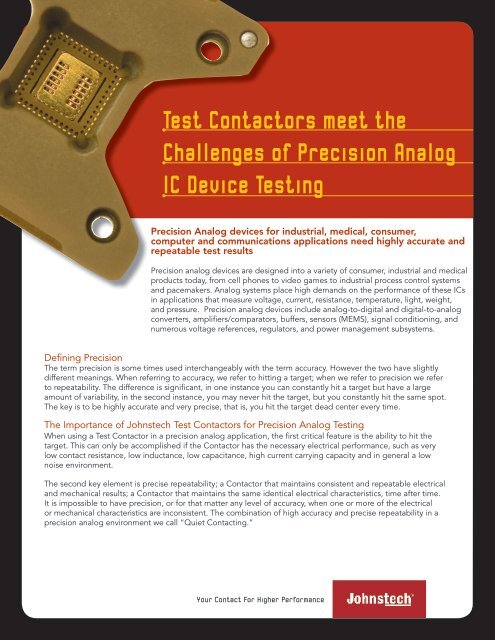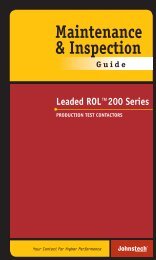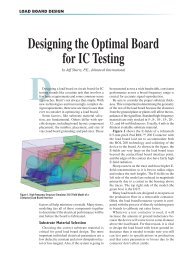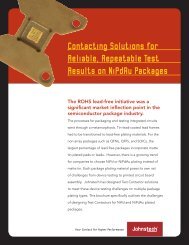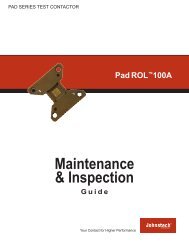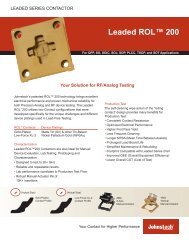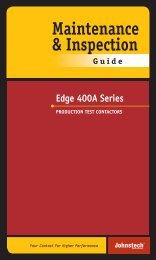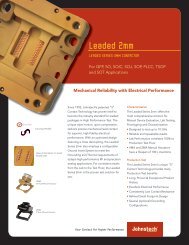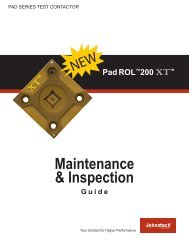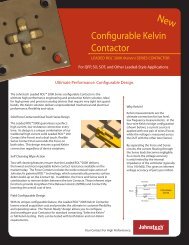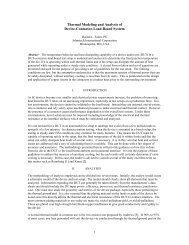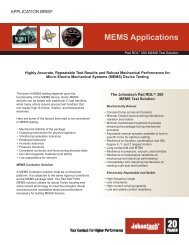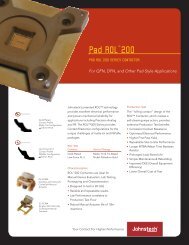Test Contactors meet the Challenges of Precision ... - Johnstech
Test Contactors meet the Challenges of Precision ... - Johnstech
Test Contactors meet the Challenges of Precision ... - Johnstech
You also want an ePaper? Increase the reach of your titles
YUMPU automatically turns print PDFs into web optimized ePapers that Google loves.
<strong>Test</strong> <strong>Contactors</strong> <strong>meet</strong> <strong>the</strong><br />
<strong>Challenges</strong> <strong>of</strong> <strong>Precision</strong> Analog<br />
IC Device <strong>Test</strong>ing<br />
<strong>Precision</strong> Analog devices for industrial, medical, consumer,<br />
computer and communications applications need highly accurate and<br />
repeatable test results<br />
<strong>Precision</strong> analog devices are designed into a variety <strong>of</strong> consumer, industrial and medical<br />
products today, from cell phones to video games to industrial process control systems<br />
and pacemakers. Analog systems place high demands on <strong>the</strong> performance <strong>of</strong> <strong>the</strong>se ICs<br />
in applications that measure voltage, current, resistance, temperature, light, weight,<br />
and pressure. <strong>Precision</strong> analog devices include analog-to-digital and digital-to-analog<br />
converters, amplifiers/comparators, buffers, sensors (MEMS), signal conditioning, and<br />
numerous voltage references, regulators, and power management subsystems.<br />
Defining <strong>Precision</strong><br />
The term precision is some times used interchangeably with <strong>the</strong> term accuracy. However <strong>the</strong> two have slightly<br />
different meanings. When referring to accuracy, we refer to hitting a target; when we refer to precision we refer<br />
to repeatability. The difference is significant, in one instance you can constantly hit a target but have a large<br />
amount <strong>of</strong> variability, in <strong>the</strong> second instance, you may never hit <strong>the</strong> target, but you constantly hit <strong>the</strong> same spot.<br />
The key is to be highly accurate and very precise, that is, you hit <strong>the</strong> target dead center every time.<br />
The Importance <strong>of</strong> <strong>Johnstech</strong> <strong>Test</strong> <strong>Contactors</strong> for <strong>Precision</strong> Analog <strong>Test</strong>ing<br />
When using a <strong>Test</strong> Contactor in a precision analog application, <strong>the</strong> first critical feature is <strong>the</strong> ability to hit <strong>the</strong><br />
target. This can only be accomplished if <strong>the</strong> Contactor has <strong>the</strong> necessary electrical performance, such as very<br />
low contact resistance, low inductance, low capacitance, high current carrying capacity and in general a low<br />
noise environment.<br />
The second key element is precise repeatability; a Contactor that maintains consistent and repeatable electrical<br />
and mechanical results; a Contactor that maintains <strong>the</strong> same identical electrical characteristics, time after time.<br />
It is impossible to have precision, or for that matter any level <strong>of</strong> accuracy, when one or more <strong>of</strong> <strong>the</strong> electrical<br />
or mechanical characteristics are inconsistent. The combination <strong>of</strong> high accuracy and precise repeatability in a<br />
precision analog environment we call “Quiet Contacting.”<br />
Your Contact For Higher Performance
<strong>Johnstech</strong>’s patented solid contact design with its self-cleaning wipe<br />
action is recognized as a world leading technology in performance and<br />
repeatability (precision and accuracy); and Quiet Contacting ROL<br />
products are extremely well suited to <strong>the</strong> demanding precision and<br />
accuracy required in today’s highly accurate analog and mixed signal<br />
applications. For example, analog to digital converters, are found in<br />
almost every segment <strong>of</strong> <strong>the</strong> market; <strong>the</strong> ability to make consistent and<br />
repeatable measurements at Least Significant Bit (LSB) levels <strong>of</strong> 24bits,<br />
and to have that measurement return <strong>the</strong> same result time after time,<br />
helps guarantee <strong>the</strong> highest first time yield.<br />
<strong>Precision</strong> Analog specifications and testing - What does it mean to <strong>the</strong> engineer?<br />
Accurate and repeatable specifications for precision analog products are directly related to yield,<br />
gross margin and pr<strong>of</strong>itability. Success depends on how well engineers can design, test and market<br />
<strong>the</strong>se high performance devices. <strong>Test</strong> throughput is also a key economic indicator. A Contactor can<br />
influence <strong>the</strong> ability to accurately and repeatably measure and qualify specifications at <strong>the</strong>se very low<br />
levels. Accurately and precisely measuring leakage current, noise floor, RDSON, Vref or various forms<br />
<strong>of</strong> low level distortion can mean <strong>the</strong> difference between wide or narrow guard bands, and high or low<br />
margins. Least significant bits (LSB) on high resolution converters can easily get lost in noise and parasitic<br />
inductive ground bounce (see figure 1). The same can be said for current carrying capability, and <strong>the</strong><br />
ability to measure resistance in <strong>the</strong> milliohm range. The old cliché definitely applies: if you can’t see it,<br />
you can’t measure it.og <strong>Test</strong>ing<br />
S 11<br />
Insertion Loss<br />
0.5<br />
0.45<br />
0.4<br />
0.35<br />
0.3<br />
0.25<br />
0.2<br />
0.15<br />
0.1<br />
0.05<br />
0<br />
Ground Inductance<br />
Pad ROL200 Contacts in Housing<br />
Ground Insert<br />
4 5 6 7 8 9 10<br />
Figure 1<br />
100<br />
Contact Resistance<br />
Gold-Plated Contact, 0.50mm Pitch<br />
Contact Resistance in mOhms<br />
80<br />
60<br />
40<br />
20<br />
Eco-1 Contact, 0.50mm Pitch<br />
0<br />
0 5,000 10,000 15,000 20,000<br />
Insertions<br />
Source: Method <strong>of</strong> reducing contactor effects when testing high-precision ADCs by Gwenole Maugard, Carsten Wegener, Tom O’Dwyer and Michael Peter Kennedy <strong>of</strong> Analog Devices & <strong>the</strong> University <strong>of</strong> Cork College,
<strong>Johnstech</strong> has charted a course in high-performance <strong>Contactors</strong>, specifically in <strong>the</strong> precision<br />
analog market. The Quiet Contactor features best-in-class, low resistance, inductance,<br />
capacitance and noise floor technology designed to minimize <strong>the</strong> effects <strong>of</strong> <strong>the</strong> Contactor<br />
and provide <strong>the</strong> test engineer a much clearer correlation between <strong>the</strong> intrinsic performance<br />
<strong>of</strong> <strong>the</strong> DUT versus a solder down device.<br />
<strong>Johnstech</strong>’s <strong>Precision</strong> Analog Contactor enhances test throughput by accurately and precisely measuring parameters without<br />
<strong>the</strong> need for averaging and time consuming algorithms that increase test time. <strong>Johnstech</strong>’s <strong>Precision</strong> Analog Contactor solution<br />
complemented by our consulting and engineering services is your choice for success. If <strong>the</strong>re’s no margin for error, you can<br />
increase your margin <strong>of</strong> success with a <strong>Johnstech</strong> <strong>Precision</strong> Analog Contactor.<br />
Mechanical Performance<br />
• <strong>Johnstech</strong> <strong>Contactors</strong> provide <strong>the</strong> mechanical reliability, stability<br />
and cleaning action needed for high volume production test, with <strong>the</strong><br />
mechanical attributes required for maintaining higher First Pass Yields<br />
(FPY), higher overall equipment efficiency (OEE), long mean time<br />
between assists (MTBA), and higher device throughput.<br />
• When using multi-site handlers, <strong>Johnstech</strong> provides excellent site-tosite<br />
Contactor repeatability, enhancing OEE and minimizing downtime<br />
compared with competitive test socket technologies.<br />
• Overall test efficiency is enhanced by repeatable Contactor<br />
performance and an optimized handler-to-Contactor interface.<br />
• <strong>Johnstech</strong>’s worldwide support and services provide <strong>the</strong> experience<br />
necessary to integrate <strong>Contactors</strong> with handling equipment and<br />
achieve optimum production test performance.<br />
Thermal and High Current<br />
• <strong>Johnstech</strong> contacting technology uses solid metal contacts.<br />
Current carrying capability is superior to non-solid contacting<br />
technologies such as spring pins. For example, even at<br />
100% duty cycle, <strong>the</strong> ROL200 easily carries in excess <strong>of</strong> 4A<br />
continuous with a temperature rise <strong>of</strong> only 20° C.<br />
• IC devices <strong>of</strong>ten need to dissipate several Watts <strong>of</strong> power.<br />
It is important that <strong>Contactors</strong> provide adequate <strong>the</strong>rmal<br />
grounding solutions that include contacts-in-housing, solid<br />
metal ground inserts, and metal inserts with contacts installed.<br />
All <strong>Johnstech</strong> grounding contacts provide superior electrical<br />
and <strong>the</strong>rmal grounding.<br />
<strong>Johnstech</strong>’s grounding for a<br />
Pad ROL100A Series Contactor.
<strong>Johnstech</strong> Services<br />
<strong>Johnstech</strong> <strong>of</strong>fers a full line <strong>of</strong> technical services to assist our customers in<br />
achieving <strong>the</strong> highest level <strong>of</strong> performance. Some <strong>of</strong> <strong>the</strong> services that are<br />
particularly useful and effective for precision analog testing are <strong>Johnstech</strong>’s use<br />
<strong>of</strong> HFSS and ADS simulation s<strong>of</strong>tware tools for modeling electrical performance<br />
<strong>of</strong> <strong>the</strong> Contactor and <strong>the</strong> interfaces between <strong>the</strong> device and <strong>the</strong> load board.<br />
Our <strong>the</strong>rmal modeling service provides direction when selecting <strong>the</strong> best<br />
Contactor ground configuration and establishing <strong>the</strong> optimal load board<br />
trace layout. <strong>Johnstech</strong>’s test floor services will help you enhance your yields,<br />
increase your performance and maintain an efficient test floor.<br />
Contact <strong>Johnstech</strong><br />
To learn more about <strong>Johnstech</strong>’s<br />
patented solutions and services that<br />
maximize your precision analog testing<br />
performance, reduce your engineering<br />
risk, and provide repeatable production<br />
test results, contact your local <strong>Johnstech</strong><br />
Sales Representative at www.johnstech.<br />
com.<br />
<strong>Johnstech</strong> <strong>Contactors</strong> for QFN/DFN Packages<br />
2mm ROL 200 ROL 100A<br />
Inductance<br />
Self: 0.50 nH 0.42 nH 0.23 nH<br />
Mutual: 0.07 nH 0.24 nH 0.14 nH<br />
Capacitance:<br />
Ground: 0.50 pF 0.22 pF 0.16 pF<br />
Mutual: 0.031 pF 0.13 pF 0.05 pF<br />
S21 Insertion Loss -1dB @ 11 GHz -1dB @ 24 GHz -1dB @ 40+ GHz<br />
S11 Return Loss -20dB @ 9 GHz -20dB @ 5 GHz -20dB @ 14.5 GHz<br />
S41 Crosstalk -20dB @ 14 GHz -20dB @ 22 GHz -20dB @ 32 GHz<br />
Current Carrying Capability: 5.20 A 4 A 4 A<br />
Contact Compliance: 0.20 mm 0.20 mm 0.175 – 0.20 mm<br />
<strong>Test</strong>ing Scenario: Engr/LVM Engr/HVM Engr/HVM<br />
Device Platings SnPb/Mtin SnPb/Mtin/NiPdAu SnPb/Mtin/NiPdAu<br />
Grounding Types STH, SCI, EI, CI RTH, RCI, CI, EI RTH, RCI, CI<br />
<strong>Johnstech</strong> <strong>Contactors</strong> for SOIC/QFP Packages<br />
Inductance<br />
Capacitance:<br />
2mm 4mm ROL 200 ROL 400<br />
Self: 0.47 nH 0.61 nH 0.42 nH 0.75 nH<br />
Mutual: 0.20 nH 0.27 nH 0.16 nH 0.33 nH<br />
Ground: 0.34 pF 0.92 pF 0.23 pF 0.83 pF<br />
Mutual: 0.15 pF 0.36 pF 0.14 pF 0.30 pF<br />
S21 Insertion Loss -1dB @ 15.3 GHz -1dB @ 4.6 GHz -1dB @ 20.7 GHz -1dB @ 5.6 GHz<br />
S11 Return Loss -20dB @ 5.4 GHz -20dB @ 1.1 GHz -20dB @ 4.4 GHz -20dB @ 1.6 GHz<br />
S41 Crosstalk -20dB @ 33.9 GHz -20dB @ 3.0 GHz -20dB @ 16.7 GHz -20dB @ 4 GHz<br />
Current Carrying Capability: 6.50 A 5.70 A 6.70 A 5.70 A<br />
Contact Compliance: 0.20 mm 0.23 mm 0.20 mm 0.23 mm<br />
<strong>Test</strong>ing Scenario: Engr/LVM Engr/LVM Engr/HVM Engr/HVM<br />
Device Platings SnPb/Mtin SnPb/Mtin SnPb/Mtin/NiPdAu SnPb/Mtin/NiPdAu<br />
Grounding Types STH, SCI, C1 STH RTH, RCI, CI RTH<br />
* LVM - Low Volume Manufacturing<br />
* HVM - High Volume Manufacturing<br />
<strong>Johnstech</strong> International Corporation • 1210 New Brighton Boulevard • Minneapolis, MN 55413-1641 USA • Tel 612.378.2020 • Fax 612.378.2030 • www.johnstech.com • E-mail info@johnstech.com<br />
© Copyright 2009, <strong>Johnstech</strong> International Corporation. Specifications subject to change without notice. No part <strong>of</strong> this document may be reproduced in any form or by any means, electronic<br />
or mechanical, including photocopying, recording or by any information storage or retrieval system, without expressed written permission from <strong>Johnstech</strong>. <strong>Johnstech</strong> and <strong>Johnstech</strong> logo are


